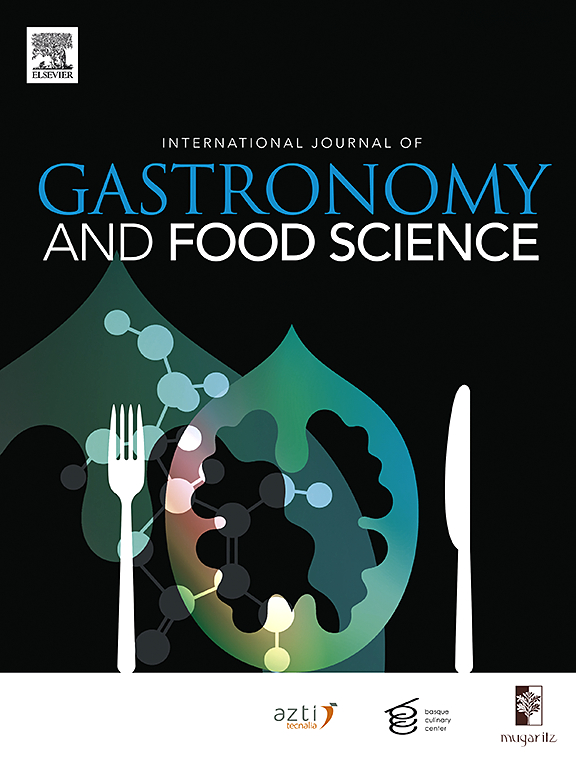Sourdough bread making: autochthonous lactic acid bacteria to optimize fermentation and enhance functional properties
IF 3.6
2区 农林科学
Q2 FOOD SCIENCE & TECHNOLOGY
International Journal of Gastronomy and Food Science
Pub Date : 2025-10-06
DOI:10.1016/j.ijgfs.2025.101315
引用次数: 0
Abstract
The increasing demand for healthier food options and lifestyles has intensified interest in fermented products such as sourdough bread, recognized for their potential health benefits and bioactive compounds. This study aimed to develop sourdough (S) and sourdough bread (SB) inoculated with lactic acid bacteria (LAB) isolated from Brazilian sourdough. Three bread formulations were prepared with different fermentation times (2, 3, and 4 h), using sourdough inoculated with Companilactobacillus paralimentarius 41 (Cp41), Lactiplantibacillus plantarum 47 (Lp47), and Levilactobacillus brevis 83 (Lb83), along with a non-inoculated control. The effects of fermentation time and bacterial strain on bread quality (physicochemical and microbiological parameters), functional properties, in vitro protein and starch digestibility (hydrolysis index and estimated glycemic index) were evaluated. Sourdough and bread dough inoculated with LAB exhibited improved yeast adaptation and higher LAB counts at the end of fermentation. The Lp47-inoculated samples demonstrated the highest production of exopolysaccharides (EPS). SBLp47 and SBLb83 fermented for 4 h presented higher acidity and the greatest in vitro protein digestibility. Among all samples, SBLb83 fermented for 3 h exhibited the lowest estimated glycemic index (73.78 ± 0.91). SBLp47 and SBLb83 showed increased lactic acid concentrations and reduced levels of fructose and glucose as a result of fermentation. After 3 and 4 h of fermentation, SBLb83 demonstrated the highest phenolic compound content. LAB-inoculated sourdough bread exhibited superior antioxidant activity compared to the control across all fermentation periods. Improvements in antioxidant activity, phenolic content, glycemic response, and protein digestibility were observed in sourdough breads inoculated with Lp47 and Lb83, highlighting their potential as promising starter cultures. A fermentation period of 3 h was identified as the most favorable condition.
酵母面包制作:利用原生乳酸菌优化发酵,增强功能特性
人们对更健康的食品选择和生活方式的需求日益增加,这增强了人们对酵母面包等发酵产品的兴趣,这些产品被认为具有潜在的健康益处和生物活性化合物。本研究旨在用巴西酵母分离的乳酸菌(LAB)接种酵母(S)和酵母面包(SB)。采用接种了副乳杆菌41 (Cp41)、植物乳杆菌47 (Lp47)和短乳杆菌83 (Lb83)的酵母和未接种的对照,制备了3种不同发酵时间(2、3和4 h)的面包配方。研究了发酵时间和菌株对面包品质(理化和微生物学参数)、功能特性、体外蛋白质和淀粉消化率(水解指数和估算血糖指数)的影响。酵母和面包面团接种乳酸菌后,酵母适应能力增强,发酵末期乳酸菌数量增加。接种lp47的样品外多糖(EPS)产量最高。发酵4 h后,SBLp47和SBLb83的酸度较高,体外蛋白质消化率最高。发酵3 h后,SBLb83的血糖指数最低(73.78±0.91)。SBLp47和SBLb83在发酵过程中乳酸浓度升高,果糖和葡萄糖水平降低。发酵3 h和4 h后,SBLb83的酚类化合物含量最高。与对照组相比,实验室接种的酵母面包在所有发酵期间都表现出优越的抗氧化活性。接种Lp47和Lb83后,酵母面包的抗氧化活性、酚类物质含量、血糖反应和蛋白质消化率均有改善,这表明它们有潜力成为有前途的发酵剂。发酵时间为3 h为最佳条件。
本文章由计算机程序翻译,如有差异,请以英文原文为准。
求助全文
约1分钟内获得全文
求助全文
来源期刊

International Journal of Gastronomy and Food Science
Social Sciences-Cultural Studies
CiteScore
5.30
自引率
10.50%
发文量
170
审稿时长
45 days
期刊介绍:
International Journal of Gastronomy and Food Science is a peer-reviewed journal that explicitly focuses on the interface of food science and gastronomy. Articles focusing only on food science will not be considered. This journal equally encourages both scientists and chefs to publish original scientific papers, review articles and original culinary works. We seek articles with clear evidence of this interaction. From a scientific perspective, this publication aims to become the home for research from the whole community of food science and gastronomy.
IJGFS explores all aspects related to the growing field of the interaction of gastronomy and food science, in areas such as food chemistry, food technology and culinary techniques, food microbiology, genetics, sensory science, neuroscience, psychology, culinary concepts, culinary trends, and gastronomic experience (all the elements that contribute to the appreciation and enjoyment of the meal. Also relevant is research on science-based educational programs in gastronomy, anthropology, gastronomic history and food sociology. All these areas of knowledge are crucial to gastronomy, as they contribute to a better understanding of this broad term and its practical implications for science and society.
 求助内容:
求助内容: 应助结果提醒方式:
应助结果提醒方式:


